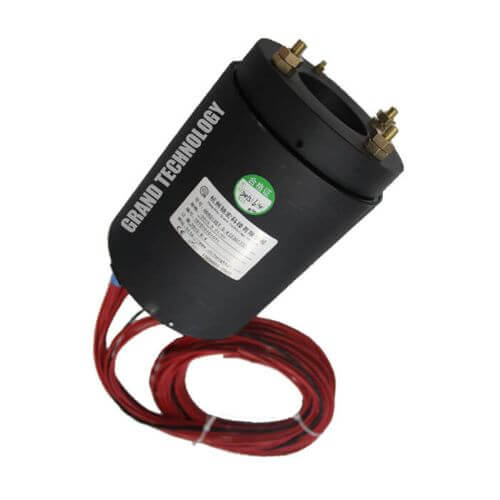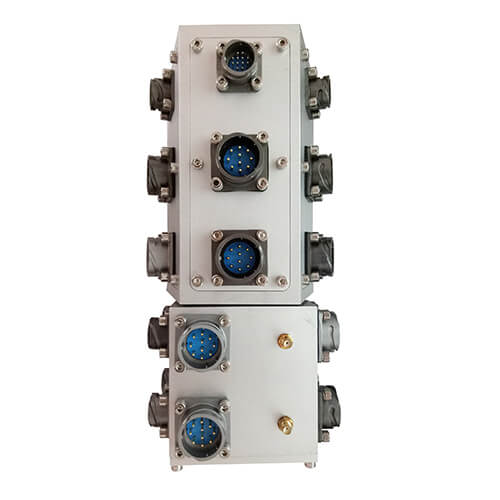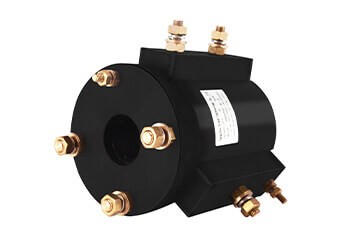High Ampere (High Amp) Slip Rings, a crucial advancement in electrical engineering, play an essential role in transmitting high electric currents from stationary to rotating structures, enabling efficient operation in heavy-duty industries such as wind energy, defense, and heavy machinery. Despite challenges like overheating and wear and tear, their remarkable capabilities have made them indispensable. This discussion aims to explore the design, advantages, potential issues, and future trends of high amp slip rings, providing a deep, concise understanding of their pivotal role in today’s industrial landscape.
Introduction High Amp Slip Ring
A high amp (ampere) slip ring is a specialized form of electrical connector designed to facilitate the transmission of high electrical currents between a stationary source and a rotating object. These slip rings, engineered with precision and composed of premium conductive materials, allow for the smooth flow of current from static to rotating components such as in a motor or a generator. Simultaneously, they also cater to signal transmission, permitting complex machinery to function synchronously.
High amp slip rings play an essential role in a plethora of industrial applications, primarily those requiring high amperage currents and signals to be transmitted across rotating interfaces. For instance, they are a central part of wind turbines, where they allow power transfer for the continuous rotation of blades and the changing of their directions.
Moreover, in automated assembly lines, high amp slip rings are crucial in machines that need to perform high-speed rotating functions while simultaneously requiring high-voltage electric power for operation. Even in the entertainment industry, they’re used in revolving stages, carousels, and roller coaster rides. In summary, the high amp slip ring’s ability to handle high current and voltage loads faithfully, and the remarkable versatility offered, contribute significantly to its importance across various sectors.

Design and Components of High Amp Slip Rings
A high amp slip ring is meticulously designed to handle high-amperage loads, a characteristic that differentiates it from traditional slip rings. The basic structure comprises conductive rings and brushes. The rings are connected to the rotating component, and the brushes, usually made from graphite or precious metals, are attached to the stationary component. Power or signals are transferred as the brushes make contact with the rotating rings.
The choice of materials in constructing high amp slip rings is crucial to maintaining effective conductivity and high performance, even in tough conditions. Frequently, engineered materials with superior conductive properties like brass and copper, along with their alloys, are used. These materials excel in reducing electrical resistance, ensuring efficient power transmission.
Traditional slip rings and high amp slip rings differ mainly by the volume of electrical current they can handle safely and consistently. While traditional slip rings work optimally for applications requiring low to moderate amperage, high amp slip rings are designed for those demanding high-powered electric energy transition.
Numerous types and models of high amp slip rings are available in the market to cater to diverse needs. These options range from capsule slip rings, which are small and compact, suitable for data and low-power signal transmission, to larger models like pancake, through-bore, and separate slip rings. Each model offers a different blend of features aimed at fulfilling the specific requirements of numerous industrial applications.
Advantages of High Amp Slip Rings
One of the most obvious advantages of high amp slip rings lies in their name itself – the capability to handle high amperage. This capacity to facilitate the transmission of large amounts of electrical power is invaluable in heavy-duty and high-power applications. High amp slip rings’ contribution to the electrical engineering industry is crystal-clear in the high-powered machinery and equipment that rely on them.
Apart from their high-current handling prowess, high amp slip rings are lauded for their ability to efficiently transmit power and signals between stationary and rotating elements. This proficiency ensures uninterrupted operation of systems, leaving no room for power transmission losses and thereby improving overall system performance.
Further, high amp slip rings exhibit immense versatility. They are designed to cater to diverse industrial applications, ranging from wind energy systems and manufacturing units to military equipment. The adaptability of these slip rings across different industries proves their robustness and scalability.
Their compact design is a critical advantage worth mentioning as well. Given that space is a premium commodity in most industrial applications, high amp slip rings deliver optimal performance without imposing substantial spatial demands, thereby making them perfect for use even in confined spaces.
Through the amalgamation of these various advantages, high amp slip rings significantly enhance the operational efficiency and robustness of numerous systems, imprinting an indelible mark on a diverse array of industries and applications.
Disadvantages and Challenges of High Amp Slip Rings
Despite their immense advantages, high amp slip rings do come with their fair share of challenges. These concerns primarily consist of the potential for overheating, size considerations, and cost implications.
High amp slip rings can dissipate significant amounts of heat due to high electrical current passage. This heat dissipation can lead to potential overheating issues, especially if measures are not in place to adequately manage the heat generated. Overheating could lead to equipment damage, deteriorate the slip ring’s performance, and in extreme cases, lead to system failure. Therefore, proper thermal management is critical when deploying high amp slip rings to ensure their reliability and longevity.
Size considerations pose another challenge. While compact designs are available, specific high amp slip rings, by necessity, may be larger and bulkier than their traditional or low amperage counterparts. Such considerable dimensions restrict their feasibility in applications where space is a constraint.
Lastly, the cost implications must also be touched upon. High-amp slip rings that feature superior materials for increased durability and performance tend to come at a premium. While they might offer numerous benefits, budget constraints and considerations can influence their adoption rate, particularly in industries plunging into cost-optimized solutions.
Understanding these challenges is vital when employing high amp slip rings. It allows for the development of better manufacturing practices, mitigation strategies, and system designs that optimize performance while addressing potential pitfalls.
Factors to Consider When Choosing a High Amp Slip Ring
Selecting the appropriate high amp slip ring for a specific application necessitates a thorough evaluation of various factors. These considerations include the current and voltage requirements, size and weight, operational environment, maintenance needs, and the manufacturer’s reputation.
- Current and Voltage Requirements: It is crucial to consider your application’s current and voltage requirements to select a slip ring that can handle the desired power levels without risking damage, degradation, or overheating. Ensure that the chosen slip ring can accommodate or, ideally, surpass your application’s electrical power needs.
- Size and Weight: Depending on the available space in the system and mounting provisions, it’s essential to consider the dimensions and weight of the slip ring. Compact and lightweight slip rings are desirable in spatially constrained applications without compromising on performance and durability.
- Operational Environment: The working environment plays a vital role in selecting the right high amp slip ring. For instance, harsh operating conditions such as extreme temperatures, high humidity, or exposure to corrosive substances may require slip rings with specialized materials, sealing, or additional protective measures.
- Maintenance Needs: The choice of a slip ring is also influenced by its maintenance requirements. Some slip rings necessitate periodic maintenance due to wear and tear, whereas others are designed to be low-maintenance or even maintenance-free, allowing for longer life spans and reducing overall maintenance costs.
- Manufacturer Reputation: Choosing a reputable, reliable, and experienced slip ring manufacturer is of the utmost importance. Quality slip rings from trustworthy manufacturers are more likely to meet your application requirements and deliver higher performance, longevity, and dependable customer support.
Taking these factors into account and tailoring choices based on primary concerns like electrical capacity, environmental, and space constraints, will ensure that the selected high amp slip ring provides optimal performance and efficiency while remaining durable and reliable within the intended application.
Common Concerns of Users about High Amp Slip Rings
Various concerns revolve around high amp slip ring usage among prospective and existing customers. These apprehensions frequently involve aspects like durability, lifespan, maintenance requirements, cost, and performance under varying conditions.
- Durability: Given that high amp slip rings often service high-powered, heavy-duty applications, they are subjected to significant wear and tear. This circumstance raises concerns about their durability and robustness against intensive usage.
- Lifespan: Correlating with durability is the concern about the lifespan of a high amp slip ring. Replacing such integral parts often can lead to increased downtime and maintenance costs, impacting overall operational efficiency.
- Maintenance Requirements: The concern about the extent and frequency of required maintenance is also paramount. Excessive maintenance interrupts normal operations and brings extra labor and cost implications.
- Cost: The relatively high cost of robust, high-quality high amp slip rings is a frequent source of worry among users. The financial implication extends beyond the initial purchase price and envelops potential repair costs, replacement needs, and associated costs of downtime.
- Performance: Concerns about a high amp slip ring’s performance under varying conditions like temperature extremes, moisture, and dust are prevalent too.
Solutions to these concerns often require a multi-faceted approach:
- Quality Products: Opting for high-quality products from reputable manufacturers counters concerns about durability, lifespan, and performance. Though this might involve some upfront increased expenses, the long-term benefits, including decreased downtime, and lower maintenance & replacement costs, are significant.
- Planned Maintenance: An adequate and regular maintenance plan can combat concerns over the necessity and frequency of maintenance as well as extend the lifespan of the high amp slip rings.
- Balanced Cost: Investing in a high-quality, durable high-amp slip ring often proves more cost-effective in the long run. While they may have a higher initial cost, potential savings can be made in downtime, repair costs, and replacement needs.
- Environment-adapted Materials and Designs: High amp slip rings designed with materials and features suited to specific environments and applications can efficiently handle the varied conditions they might be exposed to.
By proactively addressing these customer concerns, manufacturers can support customer decisions, facilitate product selection, and ensure worry-free operation of high amp slip rings in the long term.
Case Studies and Real-World Applications of High Amp Slip Rings
High amp slip rings find usage in countless industries and applications around the globe, affirming their crucial role in numerous operational contexts. Here, we delve into a few of these applications, discussing the benefits of high amp slip rings and their impacts in these contexts.
- Wind Energy Industry: Wind turbines rely heavily on high amp slip rings to transfer electrical power and signals from the stationary nacelle to the ever-rotating blades. Their ability to handle high amperage and provide uninterrupted power transmission without physical connection ensures that wind turbines operate at peak efficiency. This efficient and reliable operation leads to increased power generation and contributes indirectly to the global shift towards renewable energy sources.
- Medical Imaging Equipment: High-end medical imaging equipment such as Magnetic Resonance Imaging (MRI) machines employ high amp slip rings. These slip rings facilitate the transfer of high-resolution images from the rotating gantry to stationary computers for analysis. They are integral to the production of precise, accurate images which greatly assist doctors in diagnosis and treatment activities.
- Manufacturing and Processing Industry: Various machines and equipment in industries such as food processing, paper manufacturing, and metallurgy use high amp slip rings. They offer efficient power transfer and enhance the operational efficiency and productivity of the line production.
- Military Equipment: High amp slip rings are also crucial in various military equipment, including radar systems, gun turrets, and tanks, where they ensure reliable, continuous power and signal transmission necessary for uninterrupted and robust performance.

In all these applications, high amp slip rings offer numerous benefits, including improved efficiency, minimized power transmission losses, robustness in various operating conditions, and a streamlined operation process. In effect, they contribute towards sustainability, improved manufacturing processes, advanced medical diagnostics, and enhanced military operations.
Related Issues of High Amp Slip Rings
Alongside the numerous benefits of high amp slip rings come a host of potential issues that users may encounter. Electrical noise and interference, as well as wear and tear, are predominant concerns, which necessitate expert troubleshooting for optimal performance.
Electrical Noise and Interferences
High amp slip rings can be subjected to electrical noise and interferences, affecting signal transmission and overall performance. These disturbances may originate from external sources, like surrounding equipment or unshielded cabling, or even from the slip ring itself, due to incorrect contact material combinations or manufacturing defects.
Potential Solutions:
- Shielding: Implementing proper shielding and grounding measures for the slip ring and its cables can mitigate electrical noise and interference issues.
- Material Compatibility: Ensuring compatibility between the contact materials of the brushes and slip ring surfaces can reduce noise and provide smooth electrical contact.
- Quality Components: Opting for high-quality slip rings from reputable manufacturers with advanced designs and stringent testing procedures helps prevent electrical noise and interference.
Wear and Tear
Since high amp slip rings experience continuous rotation and high electrical loads, wear and tear are inevitable, which can subsequently lead to shortened lifespans and reduced performance.
Potential Solutions:
- Regular Maintenance: Periodic inspection, cleaning, and component replacement can minimize wear and extend the life of the slip ring.
- Material Selection: Opting for high-quality, durable conductive materials and brush technologies can decrease wear, improving performance and lifespan.
- Load Management: Ensuring that the slip ring operates within its specified load range can help prevent premature wear.
Troubleshooting Steps for Common Problems
- Loss of Continuity: Inspect for worn or damaged brushes and replace them if necessary. Also, clean the slip ring surface to remove any debris or contamination.
- Intermittent Connectivity: Check for loose connections, and examine the brush contact pressure and spring system. Adjust the pressure or replace worn components as needed.
- Excessive Heat Generation: Evaluate the slip ring for overloading, and confirm that the components fall within specified load limits. Ventilation and cooling measures may also be required.
- Electrical Noise: Investigate potential interference sources and ascertain proper shielding and grounding measures. Assess the contact material compatibility and quality as well.
By recognizing and addressing issues related to high amp slip rings, users can improve system reliability and extend operational lifespan. Regular maintenance, quality materials, and proactive troubleshooting are key actions that minimize potential problems and ensure optimal performance.
Predicted Trends and Future Improvements in High Amp Slip Rings
High amp slip rings continue to play an integral role in various industries, reflecting their importance and potential for advancement. Emerging trends, technological advances, and predicted growth contribute to future improvements that users can look forward to.
Predicted Growth of the High Amp Slip Ring Industry
Owing to the increasing demand for robust power transfer solutions across various sectors, the high amp slip ring industry is projected to experience significant growth. Expansion in renewable energy generation, growing adoption of robotics and automation in manufacturing, advancements in medical imaging technology, and evolving military applications, among others, are driving factors that contribute to this projected growth.
Advances in Technology
The following technological advancements are expected to impact high amp slip rings and positively contribute to the industry:
- Improved Conductive Materials: Innovations in material science may lead to the development of novel conductive materials for slip rings. These new materials can offer enhanced conductivity, reduced wear, and extended service life, paving the way for improved reliability and operational efficiency.
- Integration of Sensors and Data Transfer: Future slip rings may incorporate additional components and capabilities, such as integrated sensors and high-speed data transfer. This integration can help monitor slip ring performance in real time, enabling preventive maintenance and reducing the risk of critical failure.
- Advanced Manufacturing Techniques: Adopting advanced manufacturing techniques like additive manufacturing (3D printing) would allow for the production of more complex slip ring designs with tighter tolerances and custom-specific requirements. This flexibility could result in optimized designs tailored to specific applications.
- Development of Wireless Solutions: Wireless energy and data transfer methods are being explored for various applications, providing new opportunities for slip rings within specific application contexts. Whilst not replacing them outright, this technology could complement traditional slip rings in certain use cases.
Improvements Users Can Look Forward To
Technological advancements and industry growth will likely result in:
- Extended service life and improved durability through better materials, designs, and manufacturing techniques.
- Enhanced performance with reduced electrical noise and interference, providing stable and efficient power and data transmission.
- More versatile and application-specific designs, enabling streamlined integration and operation within systems.
- Expanded monitoring and diagnostic capabilities, supporting preemptive maintenance to reduce operational interruptions.
In light of these trends and advancements, the future of high amp slip rings appears promising and users can anticipate further improvements in efficiency, customization, and reliability, meeting the ever-evolving demands of the industries they support.
Conclusion
High amp slip rings, with their unique design and impressive benefits, have revolutionized numerous industries. As technology advances, we anticipate the unveiling of more compact, powerful, and efficient models set to redefine what is currently achievable in fields that rely on the power and signal transmission rendered possible by high amp slip rings.
See What We Can Do

